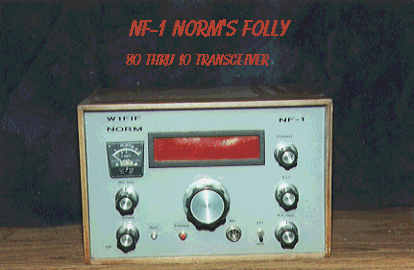
Well here it is the H.B. rig in a wooden box
I know there are better pictures but this will have to do fer now

Well here it is the H.B. rig in a wooden box
I know there are better pictures but this will have to do fer now
FRONT PANEL
As one can see all the knobs are old heath kit. The red box
in the upper center is the
frequency counter that reads down to 10 hertz. The red and white buttons
are to change sidebands and bands.
The two knobs under the S meter are the MIC gain and AF gain/
off/on. On the right side from top to bottom are the pre selector, RIT
and RF gain. The switch next to the RF gain is the VOX/MOX switch
with the MIC connector next to it. The receiver is double conversion using
ne602's, the If amp is two 1350 ic's. I use a 1496 product det. and an
LM380 as the audio out.
The front panel is made of double sided Printed Circuit board
Painted with Battle Ship Gray spray paint covered with 2 coats of clear.
All pc boards used for the subcircuits is .1 spaced prepattern boards form
Radio shack.
BAND CHANGING
Band changing is accomplished with a 7490 decage counter to
a 7441 4 line to 10 line decoder.
The logic low from the 7441 is used to turn on one of 10 pnp
transistors and each one will turn on the switching diodes needed
for each of the 10 bands. When power is applied to the NF-1 the 7490 counter
is set to 0 which put it on 80 meters. When the band switch is pressed
once the rig goes to 40 meters and each time the band button is pressed
the rig will go to the next band higher in frequrncy untill it reaches
29.5 to 30 MHZ then a press of the switch will put it back on 80 meters.
Sideband selection is also done with a counter and a 4 line
to 10 line decoder. When the rig is turned on it is in LSB, a press of
the switch then it is in USB, the next press will put it in CW
and one more press will bring it back to LSB . Sideband changes are
done as it changes bands when it switches to 80 or 40 meters it will
change to LSB and above it will change to USB.
VFO
The VFO is a L/C type using a bipolar transistor and runs on 5 to 5.5
MHZ. This VFO is a colpitts type with temperture comp. and two buffer
stages. This oscillator seems to be quite stable with only about 75 HZ
drift from a cold start.
FREQUENCY DISPLAY
The frequency counter is a 5 stage using 74192 presettsble decade
counters and only counts the VFO the BFO frequency for LSB, USB, and CW
are set by with dip switches and the HFO frequency is set by presetting
the display with diodes switched on each band. Time base is from a 1 MHZ
crystal oscillator.
RF AMPLIFIER
The RF front end uses 2 transistors a MPf102 and a 2N2222 as
the active devices. This preamp is not broad banded and has about 10 db
gain on 10 meters. This RF amplifier is also used during transmit as the
preamp before the final amplifier brick. This amp only has enough gain
to over come the loses of the Diode swithing used in the input coils and
was not broad banded because it is used as a narrow frequency filter in
transmit.
MIXERS
Both the first and second mixers are NE602 with a bandpass filter
between them at about 8 MHZ.
During receive the HFO is applied to the first and the VFO to the second.
During transmit the VFO is applied to the first and the HFO to the second.
A Fet switch using 4 MPF102's is used to do the switching of the VFO/HFO
for receive and transmit between the mixers.
IF STRIP
The If strip uses two 1350 ICS with a MPF102 used for the AGC
amp.
PRODUCT DETECTOR
The Product detector is from the ARRL Handbook and uses a Lm1496 IC.
CRYSTAL FILTERS
The Crystal filter is out of an old HW-101 and runs on about 3.3 MHZ
with a 2.1 KC band width.
For CW it has a 400 HZ filter with automatic Electronic switching between
the two.
MICROPHONE AMPLIFIER
The Microphone used in the transmitt mode uses a 1/4 of a LM324
as an amplifier and the other 3/4 of the LM324 is used for the VOX
/MOX function.
OUTPUT AMPLIFIER ( NOT SHOWN)
The output of this unit is about 100mw I use a solid state brick I
put together from old transceiver parts that has about 90 to 100 watts
out on all bands. The output band filters are switched by relays that are
energized by the NF-1.
If you have ever built a rig from scratch such as this one was, you know that the feeling you get with your first contact is a lot better than the one you get after writing out a check for a rig to get on the air.